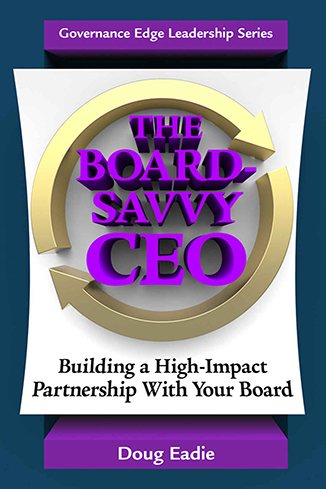 Over the course of my 30-plus years of work with economic development organization boards and their CEOs, I’ve learned that executives aspiring to take the helm of an EDO are often woefully ill-prepared to build the kind of partnership with their new board that is critical to their success and to their longevity at the top. In my book The Board-Savvy CEO (Governance Edge Publications), I discuss two major reasons for this often professionally fatal shortcoming: the absence of detailed, practical, experience-based courses on governance generally and board-CEO relationship building particularly in graduate schools of management; and the unlikelihood that an executive will become truly “board-savvy” – mastering the tricks of the governance trade – while climbing an EDO’s executive ladder. One of the most important tricks of the governance trade that these aspiring CEOs are unlikely to learn climbing the executive ladder is the use of well-designed board standing committees to preserve the CEO’s line of credit, as the following true story indicates.
Over the course of my 30-plus years of work with economic development organization boards and their CEOs, I’ve learned that executives aspiring to take the helm of an EDO are often woefully ill-prepared to build the kind of partnership with their new board that is critical to their success and to their longevity at the top. In my book The Board-Savvy CEO (Governance Edge Publications), I discuss two major reasons for this often professionally fatal shortcoming: the absence of detailed, practical, experience-based courses on governance generally and board-CEO relationship building particularly in graduate schools of management; and the unlikelihood that an executive will become truly “board-savvy” – mastering the tricks of the governance trade – while climbing an EDO’s executive ladder. One of the most important tricks of the governance trade that these aspiring CEOs are unlikely to learn climbing the executive ladder is the use of well-designed board standing committees to preserve the CEO’s line of credit, as the following true story indicates.
An EDO board’s External/Stakeholder Relations Committee held four intensive work sessions over the course of six months, working closely with the CEO and his top lieutenants in coming up with an updated strategy for managing the EDO’s relationship with key stakeholders in the region, such as the chamber of commerce, the Board of County Commissioners, the community college district, and the regional transit authority. The strategy included such initiatives as the creation of a new external relations unit to be headed by a vice president-external relations, whose portfolio would include stakeholder relationship management. The External/Stakeholder Relations Committee officially hosted the special board work session that reviewed the committee’s recommended initiatives, and the committee chair ultimately introduced the resolution creating the new unit.
This true story illustrates one of the powerful benefits of well-designed board standing committees: providing the CEO with what you might call “spear carriers” – committee chairs who take the lead in explaining and recommending action on important initiatives at board business meetings. In practice, this means that the CEO doesn’t have to expend nearly as much of her precious – and finite – line of credit in securing board action.
This very practical political benefit is one of the reasons why every really board-savvy CEO I’ve worked with over the years has been an ardent advocate for well-designed board standing committees and other vehicles for engaging volunteers and transforming them into spear carriers. Of course, there are other compelling reasons for board committees – such as more thorough preparation for board meetings – but you shouldn’t underestimate the importance of having strong champions who can help preserve the CEO’s line of credit with the board.





